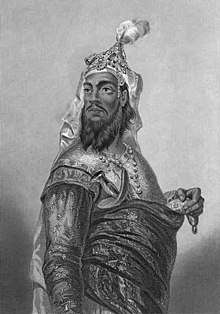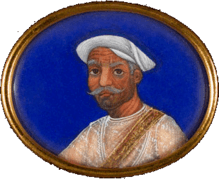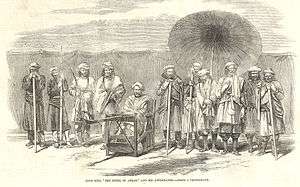Kunwar Singh
| Kunwar Singh | |
|---|---|
 "Kooer Sing", an illustration of Kunwar Singh in The History of the Indian Empire, c. 1858[1] | |
| Maharaja of Jagdispur | |
| Predecessor | Shabzada Singh |
| Successor | Babu Amar Singh |
| Born |
1777 Jagdispur, Bihar |
| Died |
April 26, 1858 (aged 80–81) Jagdispur, Bihar |
| Father | Raja Shabzada Singh |
| Mother | Rani Panchratan Kunwari Devi Singh |
Kunwar Singh (1777 – 26 April 1858) (also known as Babu Kunwar Singh and Kuer Singh) was a notable leader during the Indian Rebellion of 1857. He belonged to a royal house of Jagdispur, currently a part of Bhojpur district, Bihar, India. At the age of 80, he led a select band of armed soldiers against the troops under the command of the British East India Company. He was the chief organiser of the fight against the British in Bihar. He is popularly known as Veer Kunwar Singh.
Early life
Kunwar Singh was born on November 1777 to Maharaja Shahabzada Singh and Maharani Panchratan Devi, in Jagdispur of the Shahabad (now Bhojpur) District, in the state of Bihar. He belonged to the Ujjainiya Rajput clan.[2][3][4] He married the daughter of Raja Fateh Naraiyan Singh (a Mewari Sisodiya Rajput), a wealthy zamindar of Gaya district, Bihar, and a descendant of Maharana Pratap of Mewar.
Role in the 1857 rebellion


Singh led the Indian Rebellion of 1857 in Bihar. He was nearly eighty and in failing health when he was called upon to take up arms. He gave a good fight and harried British forces for nearly a year and remained invincible until the end. He was an expert in the art of guerilla warfare. His tactics left the British puzzled.[6]
Singh assumed command of the soldiers who had revolted at Danapur on 25 July. Two days later he occupied Arrah, the district headquarters. Major Vincent Eyre relieved the town on 3 August, defeated Singh's force and destroyed Jagdishpur. During the rebellion, his army had to cross the Ganges river. Douglas' army began to shoot at their boat. One of the bullets shattered Singh's left wrist. Singh felt that his hand had become useless and that there was the additional risk of infection due to the bullet-shot. He drew his sword and cut off his left hand near the elbow and offered it to the Ganges.[6][7]
Singh left his ancestral village and reached Lucknow in December 1857. In March 1858 he occupied Azamgarh. However, he had to leave the place soon. Pursued by Brigadier Douglas, he retreated towards his home in Ara, Bihar. On 23 April, Singh had a victory near Jagdispur over the force led by Captain le Grand (le gard in Hindi). On 26 April 1858 he died in his village. The mantle of the old chief now fell on his brother Amar Singh II who, despite heavy odds, continued the struggle and for a considerable time, running a parallel government in the district of Shahabad. In October 1859, Amar Singh II joined the rebel leaders in the Nepal Terai.[7]
Death
In his last battle, fought on 23 April 1858, near Jagdispur, the troops under the control of the East India Company were completely routed. On 22 and 23 April being injured he fought bravely against the British Army and with the help of his army drove away the British Army, brought down the Union Jack from Jagdishpur Fort and hoisted his flag. He returned to his palace on 23 April 1858 and soon died on 26 April 1858.[6]
Legacy
To honour his memory and his contribution to India’s freedom movement, the Republic of India issued a commemorative stamp[8] on 23 April 1966. Named after him, Government of Bihar established Veer Kunwar Singh University, Arrah in 1992.[9]
A play by Jagdish Chandra Mathur titled Vijay Ki Vela (Moment of Victory) is based on the later part of Kunwar Singh's life. He is also mentioned in the poem "Jhansi Ki Rani" by Subhadra Kumari Chauhan.
See also
References
- ↑ Martin, Robert Montgomery; Roberts, Emma (1858). The Indian empire : its history, topography, government, finance, commerce, and staple products : with a full account of the mutiny of the native troops ... 1. London ; New York : London Print. and Pub. Co.
- ↑ https://books.google.co.uk/books?id=SrdiVPsFRYIC&pg=PA168&dq=kunwar+singh+ujjainiya&hl=en&sa=X&ved=0ahUKEwiHhbfXg-jbAhUBShQKHV4nBlMQ6wEIKTAB#v=onepage&q=kunwar%20singh%20ujjainiya&f=false
- ↑ https://books.google.co.uk/books?id=NIv1afyxwSkC&q=kunwar+singh+ujjainiya&dq=kunwar+singh+ujjainiya&hl=en&sa=X&ved=0ahUKEwilqeH6g-jbAhWD7BQKHaJWAR4Q6AEILjAC
- ↑ Paul, E. Jaiwant (2011). The Greased Cartridge: The Heroes and Villains of 1857-58. Chapter: Kunwar Singh: Roli Books Private Limited. ISBN 9789351940104.
- ↑ "Nana Sahib, Rani of Jhansi, Koer Singh and Baji Bai of Gwalior, 1857, National Army Museum, London". collection.nam.ac.uk. Retrieved 17 October 2017.
- 1 2 3 Sarala, Śrīkr̥shṇa (1999). Indian Revolutionaries: A Comprehensive Study, 1957-1961, Volume 1. Bihar: Prabhat Prakashan. p. 73. ISBN 978-81-87100-16-4.
- 1 2 History of Bhojpur Archived 14 June 2012 at the Wayback Machine.. Bhojpur.bih.nic.in. Retrieved on 2011-10-12.
- ↑ Stamp at Indiapost. Indianpost.com (1966-04-23). Retrieved on 2011-10-12.
- ↑ Veer Kunwar Singh University Archived 29 June 2011 at the Wayback Machine.. Vksu-ara.org (1992-10-22). Retrieved on 2011-10-12.
| Wikimedia Commons has media related to Kunwar Singh. |